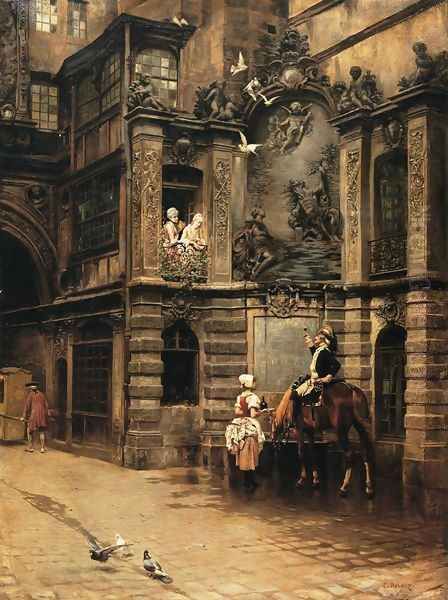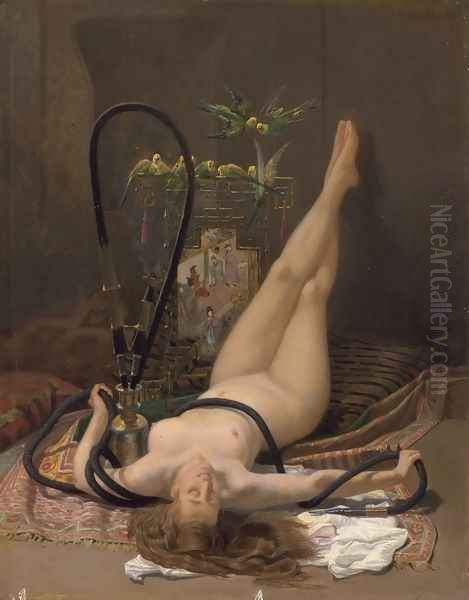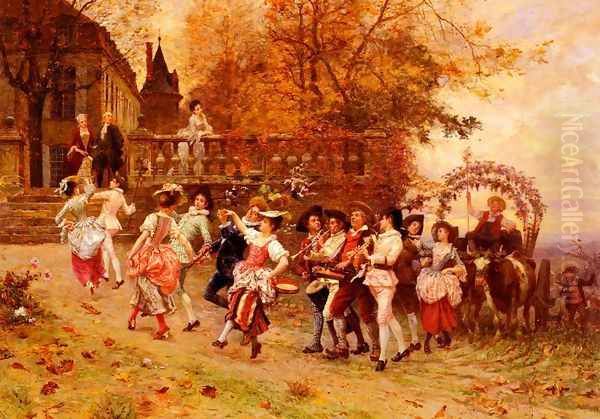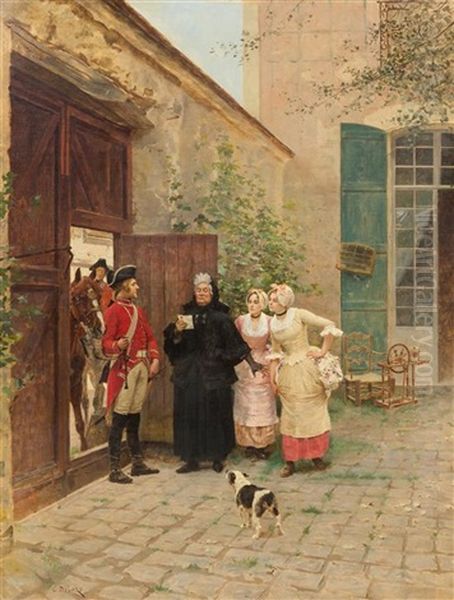Charles Edouard Edmond Delort stands as a notable figure within the French Academic art tradition of the latter half of the 19th century. Born in Nîmes on February 4, 1841, and passing away in Paris on March 2, 1895, Delort carved a niche for himself with his meticulously detailed and engaging depictions of historical genre scenes, particularly those evoking the refined atmosphere of the 18th and early 19th centuries, alongside witty portrayals of clerical life. His work, characterized by a polished technique and a keen eye for narrative, found favor with the public and critics of his time, earning him recognition and accolades within the established art world of Paris.
Early Life and Formative Influences
Charles Edouard Edmond Delort's journey into the world of art was not immediate. Born in the southern French city of Nîmes, known for its rich Roman heritage, he spent his formative years growing up near Bordeaux, a region famed for its vineyards and maritime trade. An interesting detour in his youth saw him, at the tender age of twelve, enter the Naval Academy. This early exposure to a disciplined, structured environment, though seemingly distant from the bohemian world of art, may have instilled in him a sense of order and precision that would later manifest in his detailed canvases.
However, the call of art proved stronger than the lure of the sea. By 1859, at the age of eighteen, Delort made the pivotal move to Paris, the undisputed epicenter of the art world in the 19th century. It was here that his formal artistic training began in earnest, placing him under the tutelage of two of the most influential academic painters of the era: Jean-Léon Gérôme and Marc Charles Gabriel Gleyre. This decision to study with such prominent figures was crucial in shaping his artistic trajectory.
Apprenticeship under Masters: Gérôme and Gleyre

Jean-Léon Gérôme (1824-1904) was a towering figure in French Academic painting, renowned for his historical scenes, Orientalist subjects, and almost photographic realism. His studio was a magnet for aspiring artists seeking rigorous training in drawing, composition, and the meticulous rendering of detail. Gérôme emphasized historical accuracy, thorough research, and a polished finish, qualities that Delort would absorb and make his own. The influence of Gérôme can be seen in Delort's attention to costume, setting, and the narrative clarity of his compositions.
Marc Charles Gabriel Gleyre (1806-1874), a Swiss-born artist who had established a prominent teaching studio in Paris, offered a slightly different, though equally academic, approach. Gleyre was known for his classical and mythological subjects, and his atelier attracted a diverse group of students, famously including several future Impressionists like Claude Monet, Pierre-Auguste Renoir, Alfred Sisley, and Frédéric Bazille, who studied there in the early 1860s. While Delort did not follow the path of these avant-garde painters, Gleyre's emphasis on solid draftsmanship and compositional harmony would have further solidified Delort's academic foundations. The environment of these ateliers was competitive yet collaborative, fostering a high standard of technical skill.
The Academic Tradition and Delort's Place Within It
To understand Delort's art, one must appreciate the context of the French Academic tradition. Governed by the Académie des Beaux-Arts, this tradition prioritized history painting, mythological scenes, religious subjects, and portraiture, all executed with a high degree of finish and adherence to classical principles of beauty and composition. Drawing (disegno) was considered paramount, and a smooth, polished surface that concealed brushstrokes was highly valued. Artists like William-Adolphe Bouguereau and Alexandre Cabanel were leading proponents of this style, achieving immense success and official recognition.
Delort operated comfortably within this framework. He did not seek to revolutionize art in the way the Impressionists or Realists like Gustave Courbet did. Instead, he excelled at creating charming, anecdotal genre scenes, often set in the past, which appealed to the tastes of the Salon-going public. His paintings were less about grand historical pronouncements and more about capturing intimate moments, social interactions, and the picturesque details of bygone eras.
Themes and Subjects: A Glimpse into Bygone Eras
Delort's oeuvre is characterized by a fascination with the 18th century, a period often romanticized for its elegance, wit, and aristocratic charm. He frequently depicted scenes of courtly life, leisurely pursuits, and amorous encounters, reminiscent of the spirit, if not always the style, of earlier masters like Jean-Antoine Watteau or Jean-Honoré Fragonard. His figures, often clad in elaborate period costumes, populate drawing-rooms, gardens, and taverns, engaged in conversations, games, or flirtations.

Another significant theme in Delort's work is the depiction of clerical figures, particularly cardinals and bishops, often in moments of leisure or humorous situations. These paintings, while respectful, sometimes carried a gentle satirical edge, showcasing the human side of these dignitaries. This subgenre was popular at the time, with artists like Jehan Georges Vibert also specializing in such "cardinal paintings," which found a ready market among collectors.
Delort also ventured into more overtly historical scenes, though these too often focused on the human element rather than grand, heroic narratives. His ability to reconstruct historical settings with convincing detail, from architecture and furniture to clothing and accessories, was a hallmark of his style.
Artistic Style and Technique
Delort was a consummate craftsman. His paintings are distinguished by their meticulous detail, smooth and polished surfaces, and carefully balanced compositions. He possessed a strong command of drawing, evident in the precise rendering of figures and objects. His use of color was typically rich but controlled, serving to enhance the narrative and create a harmonious overall effect.
He excelled at capturing textures – the sheen of silk, the richness of velvet, the gleam of polished wood – which added to the verisimilitude and appeal of his scenes. His figures, while often idealized in the academic manner, were imbued with character and engaged in believable interactions. The narrative in his paintings is usually clear and accessible, inviting viewers to imagine the story unfolding before them. This storytelling quality, combined with his technical skill, made his work highly popular.
Notable Works and Salon Success
Charles Edouard Edmond Delort was a regular exhibitor at the prestigious Paris Salon, the official art exhibition of the Académie des Beaux-Arts, which was the primary venue for artists to gain recognition and patronage. His works were generally well-received, and he achieved considerable success throughout his career.
One of his most recognized paintings is "Fish Friday" (also known as "Vendredi Maigre" or "A Difficult Choice"). This work humorously depicts a group of clergymen, including a portly bishop, gathered around a table laden with a sumptuous Lenten meal, primarily fish. The expressions and gestures of the figures, particularly the bishop contemplating the meager fare with a somewhat rueful look, showcase Delort's skill in capturing character and subtle narrative. The painting is a fine example of his detailed technique and his ability to infuse a scene with gentle humor, all while meticulously rendering the textures of food, fabric, and furnishings.

Another significant work is "The Embarkation of the Volunteers of 1792" (L'Embarquement des volontaires de 1792), which demonstrates his ability to handle larger, more complex historical compositions. This painting captures a moment of patriotic fervor during the French Revolution, showcasing a crowd of enthusiastic volunteers preparing to depart.
Other notable titles that reflect his thematic interests include:
"A Toast to Love": Likely a scene of gallant figures from the 18th century.
"A Voluptuous Smoke": Suggesting a moment of leisurely indulgence.
"La Fête de Vendange" (The Harvest Festival): A scene of rural celebration, perhaps with historical overtones.
"Playing Before the Bishop" (or similar titles like "The Cardinal's Amusement" or "The Cardinal's Pastime"): These works often depicted cardinals or bishops being entertained, perhaps by musicians, or engaged in leisurely activities like a game of chess or cards. One such painting, often titled "The Cardinal's Leisure" or "A Game of Piquet," shows a cardinal deeply engrossed in a card game, highlighting Delort's skill in portraying intimate, anecdotal scenes within opulent interiors.
"La Saisie des Biens d'Église" (The Seizure of Church Property): This indicates a more dramatic historical subject, likely set during the French Revolution, showcasing his versatility.
His consistent participation in the Salon and the quality of his submissions led to official recognition. He received medals at the Salon, and a significant honor came in 1882 when he was made a Chevalier de la Légion d'honneur (Knight of the Legion of Honour). This prestigious award, established by Napoleon Bonaparte, was a mark of high distinction and a testament to his standing in the French art world. Earlier, in 1875, he had also received a Salon medal, likely a Médaille de troisième classe or similar, which were important stepping stones in an academic artist's career.
Contemporaries and Artistic Milieu
Delort worked during a vibrant and transformative period in French art. While he remained true to the academic principles instilled by Gérôme and Gleyre, the art world around him was in flux. The Impressionists, including Monet, Renoir, Degas, and Pissarro, were challenging the Salon's dominance and forging new paths in painting. Realism, championed by Courbet, had already made a significant impact.

Within the academic sphere itself, Delort was one of many skilled painters. His contemporaries included giants like Bouguereau, Cabanel, and Jean-Louis-Ernest Meissonier, the latter renowned for his incredibly detailed military and historical genre scenes, sharing with Delort a passion for meticulousness. As mentioned, Jehan Georges Vibert was another artist who specialized in clerical genre scenes, often with a satirical bent, creating a friendly rivalry in this popular niche. James Tissot, though often depicting contemporary scenes of high society, shared Delort's eye for elegant detail and narrative.
Delort's choice to focus on historical genre, particularly 18th-century subjects, placed him in a popular category. There was a strong nostalgic interest in pre-Revolutionary France, and artists who could evoke its perceived grace and charm found a receptive audience. His work provided an escape into a more romanticized past, away from the rapid industrialization and social changes of the 19th century.
Later Career and Legacy
Charles Edouard Edmond Delort continued to paint and exhibit throughout his career, maintaining a consistent level of quality and popularity for his chosen subjects. He remained a respected figure within the academic establishment until his death in Paris in 1895 at the relatively young age of 54.
By the time of his death, the artistic landscape was shifting decisively. Impressionism had gained wider acceptance, and Post-Impressionist movements were emerging. Academic art, while still holding official sway, was beginning to be seen by progressive critics and artists as conservative and outmoded. Consequently, like many of his academic contemporaries, Delort's reputation experienced a decline in the early 20th century as modernist aesthetics came to dominate art historical narratives.
However, in more recent decades, there has been a renewed appreciation for 19th-century academic art. Scholars and collectors have begun to re-evaluate artists like Delort, recognizing their technical skill, their contribution to the cultural life of their time, and the intrinsic appeal of their work. Delort's paintings are now found in various museum collections and appear regularly at art auctions, admired for their charm, detail, and historical evocations.
Conclusion
Charles Edouard Edmond Delort was a master of the historical genre scene, a painter who skillfully combined meticulous academic technique with engaging storytelling. His depictions of 18th-century elegance and his witty portrayals of clerical life captured the imagination of his contemporaries and earned him a distinguished place in the French art world of the late 19th century. While not an innovator in the mold of the Impressionists, Delort excelled within his chosen tradition, creating a body of work that continues to delight viewers with its craftsmanship, charm, and nostalgic appeal. He remains a testament to the enduring allure of finely wrought narrative painting and a valuable chronicler of the tastes and sensibilities of his era. His legacy is that of a dedicated artist who brought bygone eras to life with precision, elegance, and a subtle touch of humor.